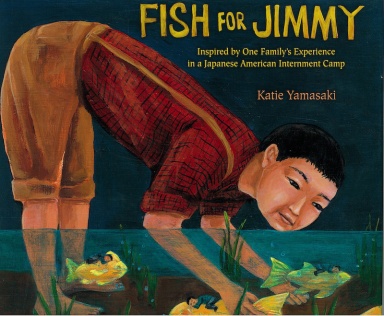

Myra here.
It’s Monday, What are You Reading is a meme hosted by Jen from Teach Mentor Texts and Kellee and Ricki from Unleashing Readers (new host of Monday reading: Kathryn T at Book Date). Since two of our friends, Linda from Teacher Dance and Tara from A Teaching Life have been joining this meme for quite awhile now, we thought of joining this warm and inviting community.

We are on the look-out for books with the following themes:
-
Stories of exile and movement from one place to another – either by choice or by circumstance
-
Narratives on im/migrants, belonging and exclusion
-
Tales of people who are in transition and displaced from their homes
-
Stories of seeking refuge and sanctuary and finding forever homes
-
Narratives of loss and dispossession

Fish For Jimmy [Amazon | Book Depository]
Written and Illustrated by Katie Yamasaki
Published by Holiday House (2013)
ISBN: 9780823423750 (ISBN10: 0823423751). Borrowed via Overdrive. Book photos taken by me.
Taro and Jimmy are Japanese American brothers who lived near the ocean. Their father, similar to most Asian Americans who migrate to the United States, opened a vegetable market, and they lived a relatively quiet life – until Japan bombed Pearl Harbor in 1941.

The first time I learned about the Japanese internment camps in the United States was through Allen Say’s Home of the Brave (Amazon | Book Depository) back in 2013 (click on the image to be taken to my review):
There is also Eve Bunting and Chris Soentpiet’s So Far From The Sea (Amazon | Book Depository) which depicted the harrowing experience of what it meant to be dispossessed of everything one owns and interned in concentration camps by virtue of one’s ethnicity.
In Fish for Jimmy, I appreciated how the entire narrative focused primarily on the interaction between brothers Taro and Jimmy, and how Taro risked life and limb to provide Jimmy with a taste of home to lift his spirits.

The Author’s Note indicated how this is based on a true story from Katie Yamasaki’s family history:
In the real story, my grandfather’s cousin snuck out of the camp to find fish for his very young son. In the book, what happened to Taro and Jimmy’s father is based on what happened to my great-grandfather Anko Kirashiki.

I believe that the more stories there are that depict truths, no matter how painful they are, the more aware young people would be to the realities of their world, and hopefully compel them to create a much more humane place, more just and equitable than the stories lived by our ancestors in the past.

A Scarf For Keiko [Amazon | Book Depository]
Written by Ann Malaspina Illustrated by Merrilee Liddiard
Published by Kar-Ben Publishing (2019)
ISBN: 9781541521643 (ISBN10: 1541521641). Borrowed from Overdrive. Book photos taken by me.
Keiko and Sam are classmates. Their teacher, Mrs. Olson, had asked them to do their “part for the war effort” by knitting socks for the American soldiers deployed to fight the Japanese in a war that has insidiously reached this suburban elementary school.

While the story may have been told before, I still found it deeply haunting how the young Keiko had to endure the unwarranted aggression and verbal taunts from classmates who used to be friends with her. Told from Sam’s perspective whose brother happens to be one of the American soldiers fighting the Japanese, the story took on a different nuance as he observes what is happening to his friend Keiko and how he opted to stand by and do nothing.

I read this book last year and re-read it once again this year for this feature, and the second reading has brought unbidden tears to my eyes, particularly towards the end, with Sam’s gradual realization of the injustice Keiko’s family had to endure.

I appreciated how the book creators included an extensive historical back matter in the end. I was just thinking how even more layered the Afterword would have been if the authors/illustrators shared their own personal experiences, if any, during this period in history. Regardless, this is a deeply moving story that caught me sideways, depicting dispossession, resilience, and hope at the same time.

#SurvivalStories2021 Update: 65 out of target 100
June 14, 2021 at 06:30AM Myra Garces-Bacsal



